#digital audio workstation (daw)
Explore tagged Tumblr posts
Text
August 2024
Ich baue mir eine Band
Ich besitze eine zweistellige Anzahl an Musikinstrumenten, die meisten davon funktionieren, und ich kann einige davon ein bisschen spielen. Aber eigentlich will ich in einer Band sein. Oder in einem Ensemble. Irgendwas. Dafür gibt es genau zwei Optionen, die eine, ein anderer Mensch zu werden und Freunde zu haben. Die andere: Overdubbing, das heißt, alles selber machen.
Seit Jahren spiele ich mit “Digital Audio Workstations” (DAW, bekanntes Beispiel ist Apples “Garage Band”), ohne damit aus dem Anfangsstadium rauszukommen. Es passiert einfach zuviel in dieser Software, als dass es Spaß machen könnte. Der Workflow fühlt sich überhaupt nicht so an wie in einer Band zu sein. Es ist eher wie grafisches Programmieren, und dafür habe ich mir kein Klavier gekauft. Seit Jahren suche ich nach dem einfachsten DAW der Welt, aber eigentlich suche ich nach etwas anderem.
Dann stieß ich durch Zufall auf Tutorials von KT Tunstall, die bei Livekonzerten mit einem Looper arbeitet. Genaugenommen mit einem Akai Headrush version 2, diesem hier.

Das ist nicht KTs Headrush, sondern meiner. Das Gerät wirkte in den Tutorials so großartig altmodisch, es ist aus Metall, kompakt, aber angenehm schwer. Ich wollte genau dasselbe. Außerdem wird es nicht mehr gebaut, ich erstand es auf dem Gebrauchtwarenmarkt für Studiohardware. Es kann drei verschiedene Dinge, aber ich brauche es, genau wie KT, nur zum Loopen. Dafür braucht man nur zwei (ZWEI) Knöpfe, die beiden am unteren Ende, und sie werden mit den Füßen bedient. Rechts ist aufnehmen, links abspielen. Ein Kabel geht rein, vom Instrument oder Mikrofon, und ein Kabel geht raus, zum Verstärker und Lautsprecher oder Kopfhörer. Insgesamt kann es 12 Sekunden aufzeichnen, zum Beispiel ein In-die-Hände-Klatschen. Dann spielt man drüber, zum Beispiel Fingerschnippen. Dann wieder, zum Beispiel zwei Akkorde. Und so weiter. Unendlich viele Schichten. Es dauert ein paar Abende, das Timing präzise hinzukriegen, aber selbst das fühlt sich schon an wie in einer Band spielen.
Jetzt muss ich nur noch die Band aufbauen. Dafür brauche ich einen Verstärker, ein Mikrofon, einen kleinen Mixer, und Instrumente. Und Kabel, Kabel sind überhaupt das wesentliche Element. Man braucht immer noch ein Kabel, das man noch nicht hat. Das große Keyboard geht direkt in den Mixer, das Mikrofon auch. Genau wie die Stompbox. Die MIDI-Instrumente gehen zum iPad, das wiederum in den Mixer geht. Der Mixer hat eigentlich nur die Funktion, alle Geräusche zu vereinen, und zwar mit Lautstärkereglern an jedem Eingang. Dann schickt der Mixer alles an den Looper, der wiederum zum Verstärker liefert. Fertig ist die Band.

Mit Hilfe des Loopers kann ich mir jetzt in wenigen Sekunden einen wirren Hintergrund erzeugen, auf dem ich improvisieren kann. Es hilft, wenn der Hintergrund nur ein, zwei Akkorde hat. Vorschläge für Songs dieser Art nehme ich gern entgegen. “Love You Madly” von Cake habe ich schon. “Seven Nation Army” auch.
Moment, was ist noch gleich eine Stompbox? Mein neues Lieblingsinstrument: Von außen sieht es aus wie ein Holzklotz, und viel mehr ist es auch nicht. Drinnen ist irgendein elektrisches Element, das elektrische Bumm-Laute erzeugt, wenn man mit dem Fuß drauf haut. Eine total einfache Bassdrum. Oder eine Stompbox. Ich fand meine Stompbox auf Facebook Marketplace, und kaufte sie auf dem Markt um die Ecke von einem schottischen Gitarristen.
(Aleks Scholz)
9 notes
·
View notes
Text
Me and FL studio are in a relationship but rn we’re just kinda feeling things out so it’s an open relationship and I’ve heard some good things about Logic Pro so I may ask him if he’s free
8 notes
·
View notes
Text
I wish that more people would get into composing music, because it's fun and therapeutic and neat, but like. It's really fucking expensive if you're looking into typical, professional equipment, so I understand why they don't.
Personally, I just don't think you need to start out on a DAW. It feels unnecessary, and it feels like it's an easy way to gatekeep art from the poor. "Professional" Music software ropes people into spending, like, $500+ on the software alone, and then expects them to be able to play an instrument, which involves owning an instrument which varies wildly in price depending on what the instrument is and if it's well-made.
(there's also the occasional software that's aimed at people who are able to record themselves playing that instrument and like...the logistics of that costs a lot, but it's not strictly required or anything. there's also an argument to be had here about the culture surrounding machine-produced sounds as opposed to human-performed sounds, and I'm just not gonna get into it right now)
That's why I don't fucking use a DAW. I'm poor!
I got started on Flat.io, which is not a DAW, but it is free! It's kind of like Noteflight or Musescore if you're at all familiar with either of those things, but the general consensus is that Musescore is better than Flat is better than Noteflight. I've never used Musescore. But I know that Flat is better than Noteflight. It's just a website that has really good instrument variety. It's primarily limited by the fact that you can only use western musical notation. You're also limited to 15 scores without their subscription service (which I got a lifetime membership on for like 150 dollars? but i think they've increased the price since then? dont know, cant see it anymore) but honestly it's not so bad because they don't enforce the ban on multiple accounts as hard as they say they do.
So I guess what I'm saying is like...even if you don't know what you're doing and you're really nervous and you don't want to share anything and you think it costs way too much money (because it does), like...give it a shot. Go digging for artistic software, regardless of the medium, and eventually you will find what you want. And even though the free services can get penny-pinching at times, there's usually at least one out there that can show you whether or not you really want to get into it before you hit the paywall.
And also what I'm saying is go look at Flat.io. Because it's cool. And I've used it for years. And I really like it. And you should go look at it.
#DAW stands for Digital Audio Work<something> btw#sometimes i hear it called Workshop#sometimes i see it referred to as Workstation#sometimes it's Workplace#they all mean the same shit#music
15 notes
·
View notes
Text
taking recommendations for free daws if you have the time, search engines just want to sell me junk
2 notes
·
View notes
Text
Impact Soundworks – Ventus Series Ocarinas for Authentic
Download

Embark on a musical journey like no other with Impact Soundworks – Ventus Series Ocarinas, a virtual instrument library that transports you to enchanting realms with the haunting melodies of ancient ocarinas. Crafted with meticulous attention to detail, this collection captures the soulful tones and expressive nuances of these traditional wind instruments, allowing you to infuse your compositions with the mystique and allure of distant lands.
With Impact Soundworks – Ventus Series Ocarinas, you gain access to a diverse array of ocarina sounds, each meticulously sampled and expertly crafted to deliver unparalleled realism and depth. From the delicate timbre of ceramic ocarinas to the earthy resonance of wooden flutes, every instrument in this collection offers a unique sonic palette to inspire your musical creations.
But Ventus Series Ocarinas is more than just a virtual instrument – it's a gateway to musical exploration and discovery. With its intuitive interface and versatile feature set, you can effortlessly shape your sound to suit your creative vision, whether you're composing cinematic soundtracks, scoring video games, or producing ambient electronica.
#Sure#here are some tags for “Impact Soundworks – Ventus Series Ocarinas”:#1. Virtual instrument#2. Ocarina#3. Impact Soundworks#4. Ventus Series#5. Music production#6. Folk music#7. Ethnic instruments#8. Sound design#9. Sample library#10. Musical expression#11. Artistic innovation#12. Cultural heritage#13. Wind instruments#14. Composition#15. Performance#16. Realism#17. Instrument emulation#18. Digital audio workstation (DAW)#19. Musical creativity#20. Sonic exploration
2 notes
·
View notes
Text
Does anybody know of a music DAW that's like. intermediate level?
I've started music making on This Shit
not to say it's bad at all, it's awesome, it's also kinda an mspaint of music making and I want to find a DAW between that and the ones with a million different features.
For example: I started drawing digital art on mspaint, then went to ibispaint x on my phone, then to clip studio, and it was the smoothest experience of my life.
I'm trying to find the Ibispaint of music production.
#music production#npc-dialogue#making music#digital audio workstation#audio workstation#daw#help#pxtone#cakewalk would be great if I wasn’t overwhelmed immediately by the million things#i use windows btw so I cant do garage band
4 notes
·
View notes
Text
Mastering Sonic Excellence: Explore Lexicon PCM Total Bundle for Unparalleled Audio Processing
Lexicon PCM Total Bundle: A Comprehensive Suite of Professional Audio Processing Tools
Explore the pinnacle of audio processing with the Lexicon PCM Total Bundle, a meticulously crafted collection of premium plugins designed to elevate your sound to new heights. Immerse yourself in a world of unparalleled reverbs, delays, and effects that have defined the industry standard for decades. From the lush and expansive reverberations to the precise and intricate delays, each plugin within the PCM Total Bundle is a testament to Lexicon's legacy of excellence in audio engineering. Unleash the power of iconic Lexicon algorithms on your recordings, bringing forth a sonic richness and depth that will transform your music production experience. Whether you're a seasoned professional or an aspiring artist, the Lexicon PCM Total Bundle is your gateway to a world of sonic possibilities, ensuring your music stands out with clarity, dimension, and brilliance. Elevate your audio production game with the unmatched quality and sophistication of Lexicon's PCM Total Bundle.
#music#music production#Lexicon PCM Total Bundle#Audio Processing#Reverb#Effects#Studio Plugins#Lexicon Sound#Pro Audio#Signal Processing#Mixing and Mastering#Digital Audio Workstation (DAW)#Audio Engineering#Studio Tools#Sound Design#Professional Sound#Music Production#Recording#Audio Effects#Studio Essentials#Production Plugins#Lexicon PCM#Digital Signal Processing#Creative Sound#Audio Editing#Production Software#Professional Audio#Audio Technology#Electronic Music#Sonic Exploration
2 notes
·
View notes
Text
Editing on Reaper DAW has become silky smooth thanks to the abilities to customize track colours and add quick key shortcuts for things I use frequently. It's actually a moderately enjoyable experience now!
I put off learning it for so long because it looked complicated and I was intimidated, but most of my questions can be quickly googled and resolved.
3 notes
·
View notes
Text
Discovering the Power of Reaper: My Go-To DAW for Music Production
In the expansive world of digital audio workstations (DAWs), Reaper stands out not just for its robust features and affordability but as my DAW of choice for all my music production needs. From the intricate beats crafted for the Garlic Farm project to the diverse soundscapes explored in my other works, Reaper has been an indispensable tool in my creative arsenal. Here’s why Reaper has earned its…
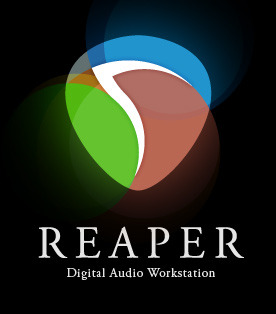
View On WordPress
#Advanced Music Production#Audio Editing#Audio Mixing#Audio Production Tips#Audio Routing#Beat Making#Beatstars#Customizable DAW#Digital Audio Workstation#Efficient Music Software#Free Beats Download#Garlic Farm Project#Home Studio Setup#MIDI Sequencing#Multi-Platform DAW#Music Automation#Music Composition#Music Creation Tools#Music Production#Music Production Guide#Music Software Review#Professional Audio#Reaper DAW#Reaper for Beginners#Recording Software#Sound Design#VST Plugins
1 note
·
View note
Text
Universal Audio Plugin Bundles at Unbeatable Prices - Up to 60% Off!
Universal Audio Plugin Bundles at Unbeatable Prices. Experience the revolution in audio production with Universal Audio Plugins, now fully compatible and natively running on both Mac and Windows platforms. This significant advancement has made these premium plugins more accessible than ever, eliminating the need for specific UAD hardware. Embrace this change and dive into the world of superior…
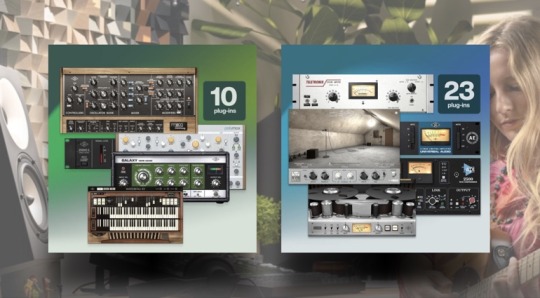
View On WordPress
#176 Classic Limiter Collection#60% Off#API 2500 Bus Compressor#Brigade Chorus#DAW#deal#Digital Audio Workstation#Download#effects#Free#Galaxy Tape Echo#Hammond B3#Home Studio#instruments#Lexicon 224 Digital Reverb#LUNA#MAc#Minimoog#Native#Opal Morphing Synth#PC#Plugins#PolyMAX#Pure Plate Reverb#Ravel Grand Piano#Sale#studio#Studio D Chorus#Thomann#UAD
0 notes
Text
Pengertian DAW Digital Audio Workstation
Digital Audio Workstation (DAW) adalah perangkat lunak atau aplikasi yang dirancang khusus untuk merekam, mengedit, dan memproses audio secara digital. DAW digunakan oleh produser musik, insinyur suara, dan musisi untuk membuat, mengedit, dan menghasilkan musik atau proyek audio lainnya. Fungsi utama dari DAW meliputi: Rekaman Audio: DAW memungkinkan pengguna merekam sumber suara dari berbagai…

View On WordPress
0 notes
Text
Applying Compression to my Tascam DP32SD Tracks
The Dilemma: As much as I love my Tascam DP32SDs (I use two of them), they're missing one key feature – compression. Very often, when tracking, the audio levels are inconsistent (that would be an 'operator issue' on my part). I don't particularly like compressing as I record. In the past, I've always compressed during the mixdown, using the dynamic compression inserts on my mixing board. But things are different now, and I just don't have multiple inputs and outputs to feed into my beloved analog boards.
The Challenge: My usual suspects for recording the majority of my tracks involve a combination of my Roland TD-50 drum module, an Optimus MD-1200 keyboard, Carvin X1 amp pedal and a Boss IR-200 cabinet simulator. This pretty much covers a whole band – drums, bass, guitar, keys. They sounded great with the proper levels, but what they really needed was a bit of compression to bring them to life. The DP-32SD, for all its merits, doesn't come with the tools for this job. I thought about upgrading to the later (and yes, very sleek) Tascam Model24s, but the thought of spending over $2,500 and having my faithful DP32SDs collecting dust? This is not practical for a number of reasons and I'm sure I'll arrive to this explanation on a later post.
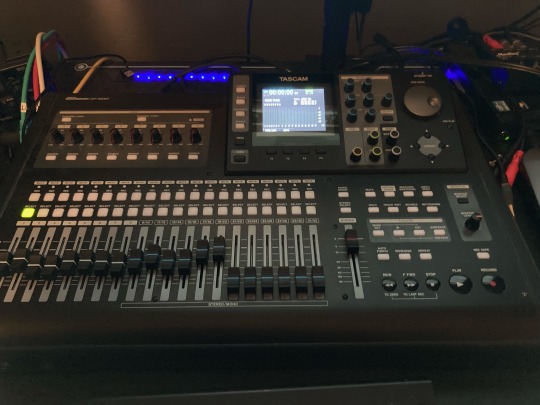
My Strategy: As much as I avoid Digital Audio Workstations (DAW), I needed something to tame and brighten the dynamics of my raw audio tracks. Now I would never tell a person how to manage their equipment, or which tools to use, but I personally believe that understanding DAWs is necessary and we should maintain access to one. This could be an inexpensive DAW with limited features. This is why when it comes to computing, I use open source software and my DAW of choice is REAPER. Years ago, I could have given you all kinds of tips on Cakewalk Guitar Tracks Pro and Sonar, but notice how they no longer exist? Okay, I'm jumping the shark again- I'll talk about this in another post.
Exporting Tracks: The Tascam records all files in WAV format, and I have them defaulted to 16-bit. These files can be exported separately by use of the DP32SDs "Audio Depot." The Audio Depot is a reserved directory found on the SD Card used for your recording sessions. I exported all my raw tracks to the Tascam Audio Depot in the defaulted WAV format.
DAW Integration: Next, I brought these tracks into REAPER, my Rocky Linux digital audio workstation and this is actually a simple process. Shut down your Tascam (save your work!) and move your SD card from the Tascam to the DAW. From this point, you use the REAPER graphical user interface (GUI) to add each raw WAV file as a track. A beautiful feature about the Tascam Audio Depot, is that every file you export to the depot is the exact same time length. This makes it VERY easy to align your tracks in your DAW to play the tracks in sync.
Applying Compression: REAPER has a native set of plugins that are arguably industry standard, especially if you don't rely on audio effects exclusively. Each plugin name is prefaced with "Real," so I chose the RealComp VST compressor and applied one instance of this plugin to each raw track. This compressor reminds me of the outboard Behringer Autocom Pro and some of the other ART, Alesis and Nady compressors from the 80s and 90s. The developers built out numerous presets, so I was able to choose "Rock Snare" for the snare, "Rock Bass Drum" for the kick, etc. I was also able to apply similar presets to the guitars and the keys. Fine-tuning each preset was very easy to do by adjusting the threshold or even a ratio adjustment. Each track ended up with its own perfect compression setting.
Rendering and Returning: REAPER uses the term 'render' to finalize a mix. Rendering will basically 'play' the track internally and record this mixed version to a new file. This can all be done under the File -> Render section. Once I had all my tracks dialed in with the right compression, I rendered each one separately to their own dedicated tracks. Now when you render your tracks in REAPER, it's a good idea to set up your naming convention. Under the Render options interface, I was able to auto-name each track to be the same as the name of each track on the REAPER virtual mixing board. Examples of track names could be: 01-BD (track one, bass drum), 02-SN (track two, snare), 11-BASS (track eleven, bass guitar), 12-GTR1 (track twelve, guitar 1), 13-GTR (track thirteen, guitar 2)... Once this was complete, I copied these files to the DP32SD SD card's Audio Depot directory (delete the old files first!). Eject the SD card, and place back into the Tascam.
Re-importing to Tascam: The final step was bringing these compressed tracks back as a new song on my DP32SD. You create a new song and then under the song options, select IMPORT. IMPORT takes you to the Audio Depot and you can simply add each track according to the naming convention you used. 01-BD would be imported to track one, and 13-GTR1 would be imported to track thirteen. At this point, you have a brand new song with your files compressed and ready to mix.

The Outcome: Immediately, I noticed my audio levels to be much easier to work with. I almost felt like I was mixing tape! I think the biggest takeaway regarding recording digitally, is that your digital recorder is going to capture sound much differently than your older analog tape recorders. I remember so many times in the past, when I would set up a couple microphones on some instruments and run them through a mixer to tape, and the dynamics were much easier to manage. My opinion on this is that tape itself does have a natural compression and saturation, which makes the levels easier to work with. Many engineers like to use tape to ride the red lines on the VU meters. Unfortunately for us, these are expensive glory days for us to reflect on. We do have to adapt to the economics of technology by convenience, and this is not a complaint. A good adaptation is adding minor compression to your tracks. The challenge is what is the best way to do this? Well, you could compress as you track, but depending your project, you many need a rack of compressors and preamps. This is a space, resource and price problem. And once your track is recorded with compression, you can't change what was recorded. So, compressing after in a DAW seems to be my current method. This will change in the future. Tascam is continuously making improvements, especially in the newer Model24 series. I'll eventually get to write about why the Model24 isn't quite where I want to be in terms of an upgrade. So for now, the DP-32SD is still my choice of platform. The process of compressing my files in REAPER took about two hours and that included the learning curve, and other interruptions, but within a couple hours, my tracks were transformed. They sounded incredible, like they had been given a new lease on life. So this wasn't just about avoiding an upgrade. It was about taking control of my sound in a way I hadn't imagined before. The Model24s might have been a neat upgrade, but the Model24s also have their own issues. I will likely discuss this on future episodes of the guntersouds.NET podcast.
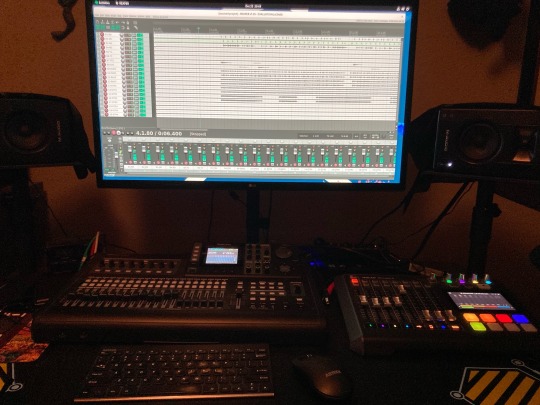
Reflections: The developers who contribute to REAPER's VST plugins should be awarded Medals of Honor. Think of the contribution that these unknown heroes have made! I strongly recommend a donation to the REAPER team when possible. What I learned from this whole process is that usually, the best gear is what you already have, combined with a little ingenuity. It's about marrying the tactile, hands-on feel of analog with the endless possibilities of digital. In the end, not only did REAPER help me resolve my compression issue, but I also discovered a new and exciting way to prolong the lifespan of my Tascam DP-32SD.
0 notes
Text
Celemony Melodyne Studio 5 Download Windows & Mac Full Version
Celemony Melodyne 5 Studio: Mastering Pitch and Time with Precision
Revolutionizing Pitch and Time Correction: For years, Celemony's Melodyne has led the charge in pitch- and time-correction technology, transforming the way musicians approach editing. Melodyne 5 Studio takes this legacy to new heights, introducing groundbreaking features that redefine the art of vocal editing.
Polyphonic Precision: Melodyne 5 Studio's prowess lies in its complete polyphonic tuning via DNA (Direct Note Access). It allows you to delve into the intricate details of your audio, separating pitched and noise-like components. The result is a level of musicality and pitch deviation analysis that sets a new standard in the industry.
Innovative Tools for Artistic Control: The Fade Tool, a standout feature, empowers you to create note-based fades even in polyphonic recordings. The Melodic algorithm edits pitched and noise-like components separately, offering unparalleled control. The Sibilant Tool allows per-note adjustment of volume between pitched and unpitched vocal sounds, while the Leveling Macro minimizes volume disparities between notes.
Harmonic Adaptation with Chord Track: Introducing the Chord Track and Chord Grid, Melodyne 5 Studio enables swift adaptation of notes or entire chords to harmonically suit your composition. This feature, coupled with musically weighted pitch analysis, ensures psychoacoustically optimal intonation correction.
Enhanced Polyphonic Editing: Melodyne 5 Studio introduces advanced algorithms, including the Percussive Pitched algorithm designed for instruments like tabla, berimbau, and 808 kick drums. The software facilitates recallable search functions for keyboard shortcuts, enhancing your workflow efficiency.
Multitrack Note Editing: With Melodyne 5 Studio, you can work seamlessly with multiple tracks simultaneously. The software's unique pitch-shifting and time-stretching capabilities make it a preferred tool for refining individual tracks or shaping complex musical arrangements.
Integration Options for Ultimate Workflow: Melodyne 5 Studio offers flexibility in integration. Whether used as a standalone application or as a plug-in within your DAW, the software adapts to your preferred workflow. The ARA interface provides complete integration with selected DAWs, allowing you to open and edit tracks directly in Melodyne.
Effortless Navigation, Limitless Creativity: Melodyne 5 Studio maintains its reputation for user-friendly operation. Context-sensitive tools, logically arranged menus, and intuitive arrange and edit windows make navigation ultra-simple. From subtle corrections to extreme transformations, Melodyne 5 Studio caters to your every creative whim.
In the realm of pitch and time correction, Melodyne 5 Studio stands as a masterpiece, offering a comprehensive set of tools for musicians, producers, and recording engineers. Elevate your sonic possibilities and achieve unprecedented control over your musical expressions with Melodyne 5 Studio.
#Melodyne Studio 5#Audio Editing#Pitch Correction#Music Production#Vocal Editing#Sound Design#Audio Processing#Celemony#Music Technology#Studio Software#Audio Manipulation#Pitch Shifting#Vocal Enhancement#Music Editing#Digital Audio Workstation (DAW)#Music Software#Harmonization#Audio Analysis#Studio Plugins#Audio Engineering#Creative Sound Editing#Audio Pitch Editing#Melodyne Features#Audio Production Tools#Studio Effects#Music Arrangement
1 note
·
View note
Text
Actually, new post with tags in hope of help.
I need some decent sound fonts or DAW software, preferable that I can use in our around a MuseScore→Audacity workflow on Linux. But I do have windows too if needs must.
The instruments that I need are:
Electric guitar with variable overdrive
Electric bass
Horns
Toms
Snare (can probably use one I already have)
Rainstick
Synth strings (again, can probably use one I have)
I wish I had a Soundblaster or something but everything must run in software.
1 note
·
View note
Text
The Ultimate Guide to Dubstep Music Production
The Ultimate Guide to Dubstep Music Production This comprehensive guide to producing dubstep music is perfect for both beginners and experienced producers looking to take their tracks to the next level. With a focus on technical tips, tricks, and practical suggestions, this book covers everything from sound design and arrangement to mixing and mastering. Whether you’re just starting out or you’re…
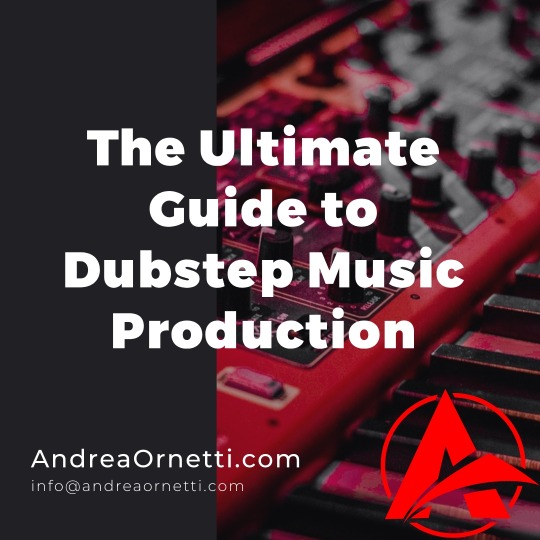
View On WordPress
#andrea ornetti#Digital audio workstation (DAW)#mastering#Music production#Music production software#powerful#Production#Sound design#suggestions create#tips#tracks#tricks
0 notes
Note
how did you get started making music, tools-wise?
I've talked about this a bit before and I don't necessarily recommend doing this, so skip the following two paragraphs and go right to the one under the break if you actually want the method I recommend
I lied to a girl I liked from my school and told her that, because I could play guitar I could also play piano, so I could teach her to play piano. both of these statements were lies.
I had to panic and learn both guitar and piano one week ahead of the lessons I was giving her as an excuse to hang out. so I self-taught in a haze of panic and "maybe she'll like me" (she did not) (but she kind of did) (but she was bicurious) (but she was wishy-washy on if she wanted to get together and her parents didn't like me) (and her parents were homophobic) (I think she might have texted me at one point years down the line to tell me she had a girlfriend but it was after I deleted our text history and I'm chronically unable to remember to put people's names into my contacts so who knows)
but that's all an aside. that's a bad method.
anyway if you want to start making music in earnest, doing what I did when I got serious about making songs instead of trying to impress girls whose parents wanted to destroy me with their minds here's a better answer
go acquire FL Studio. it's apparently really easy to do this because people have been acquiring it for years, or so I've heard. FL is good for learning because you've got 20 years worth of free tutorials available to you on youtube to dig through and plenty of stock vsts to play with out of the box
FL Studio is, realistically, the only tool you actually need to start making music. you could get away with less, but it's what I used, and as long as you don't pick up Specific Bad Habits, your experience with it will transfer to other DAWs if you decide to switch it later
that's all, really
if you go this route, the golden rule I'm going to impart on you right now is that you need to have a limiter on your songs. the default FL studio song templates have one, so you should keep it until you know enough to know why you might adjust something like that
it doesn't matter if it sounds fine in the editor without a limiter. everyone thinks it's not a big deal at the time, but as you get more experienced, there's literally nothing short of getting in legal trouble that you'll regret more than realising that your old work is almost entirely unsalvageable because you didn't put a limiter on it and now half of the audio is just lost data to clipping
I'm gonna put a few more recommendations for things I've used, just so you can consider them if you need something else to chew on. everything past this point is entirely optional and you'll do just fine with FL Studio alone. in fact, probably don't worry about everything below the line
-=-
items marked with [F] are free.
DIGITAL AUDIO WORKSTATIONS THAT AREN'T FL
for tracker-based editing and chiptunes, use Renoise. you'll either love or hate trackers, and while they have a steeper learning curve than piano roll DAWs, they might come more naturally to you. I personally think that Renoise is a lot of fun to use. it kinda has an "addictive" quality to it, as funny as that is to say
for quickly sketching songs, use [F]Jummbox. it's an html workstation (multiplatform!) that writes your sketches to a url, meaning it's pretty easy to collaborate on musical sketches. Jummbox is good for making chiptune style instrumentals, but what makes it especially accessible is the fact that it works on a piano roll system, which will be familiar to you if you're working in FL
for writing sheet music, I recommend starting with [F]Musescore. I'll warn you right now that there aren't really any good notation editors and you're making lesser-of-evils decisions when you pick any of them, but it's probably the best compromise out there right now. it's the one I use when I need to hand something to a physical musician. you can also export pieces as midi, although there's better ways to do that lol
-
VSTs
if you can acquire Pianoteq, do that. if you feel uncomfortable with acquiring it, [F]Keyzone Classic is free and can sound pretty nice with a bit of work, but you really have to learn to work with it
if your workstation can handle it performance-wise, go pick up [F]Vital - Spectral Warping Wavetable Synth. there's tons of free presets for this out there and it sounds good. cool synth. Serum: Advanced Wavetable Synthesizer is also good and has plenty of presets, but it's on the pricy side, so consider how comfortable you are with [finding a friend to buy it for you]
[F]Decent Sampler doesn't do much out of the box, because it's just a tool for playing sample banks, but if you go to [F]Pianobook, you can find tons of weird and fun sample packs of just about everything you can imagine. sounds derived from folk instruments, industrial equipment, lego sets, stylophones, choirs, whatever. incredibly useful.
Valhalla VintageVerb. this is the reverb plugin. you want this one. [F]Valhalla Super Massive is also good but it's more focused on alien-sounding reverb effects and enormous spaces, so it's kind of got a niche use case and you should be a little careful with it
if you've heard a lo-fi hip hop song on youtube, it probably used [F]iZotope Vinyl. this one can save you a lot of time if you're going for that sound because it comes with all the little vinyl flourishes outside of compression (like dust crackling) that you'd otherwise have to add yourself
[F]Genny VST is advertised as giving a genesis/megadrive sound, but what actually makes it shine is that it's an actual synth emulating the YM2612 and SN76489 sound chips. this means you can create your own sounds that work within those specs, which is a lot of fun! definitely beats just using samples, if you ask me
-
HARSH VSTS THAT I PERSONALLY LIKE BUT WHICH ALSO MIGHT !!HURT!! YOU. SO BE VERY CAREFUL USING THESE.
[F]Tritik Krush is a bitcrushing plugin. it does a good job of bitcrushing and downsampling. I use it a lot in my songs, but you've really gotta know how to keep this one under control, because it's fully capable of making painful sounds on accident and can completely devour your mix
[F]FSA Latcher is a gorgeous noisebox. it screams in horrible ways and makes dying machine noises in various colours. this is the musical equivalent of working with radioactive material, so be extremely careful using this in anything you don't want to hurt the listener's ears
girlfriend just told me I have to recommend [F]Noise Engineering Ruina to you if I'm making a category with this heading. I don't personally use it, but she likes it (she's better at music than I am) and it's free, so you should go pick it up. "it annihilates sounds very deliciously" (maybe I should use it)
-
hope that helps a bit!
186 notes
·
View notes